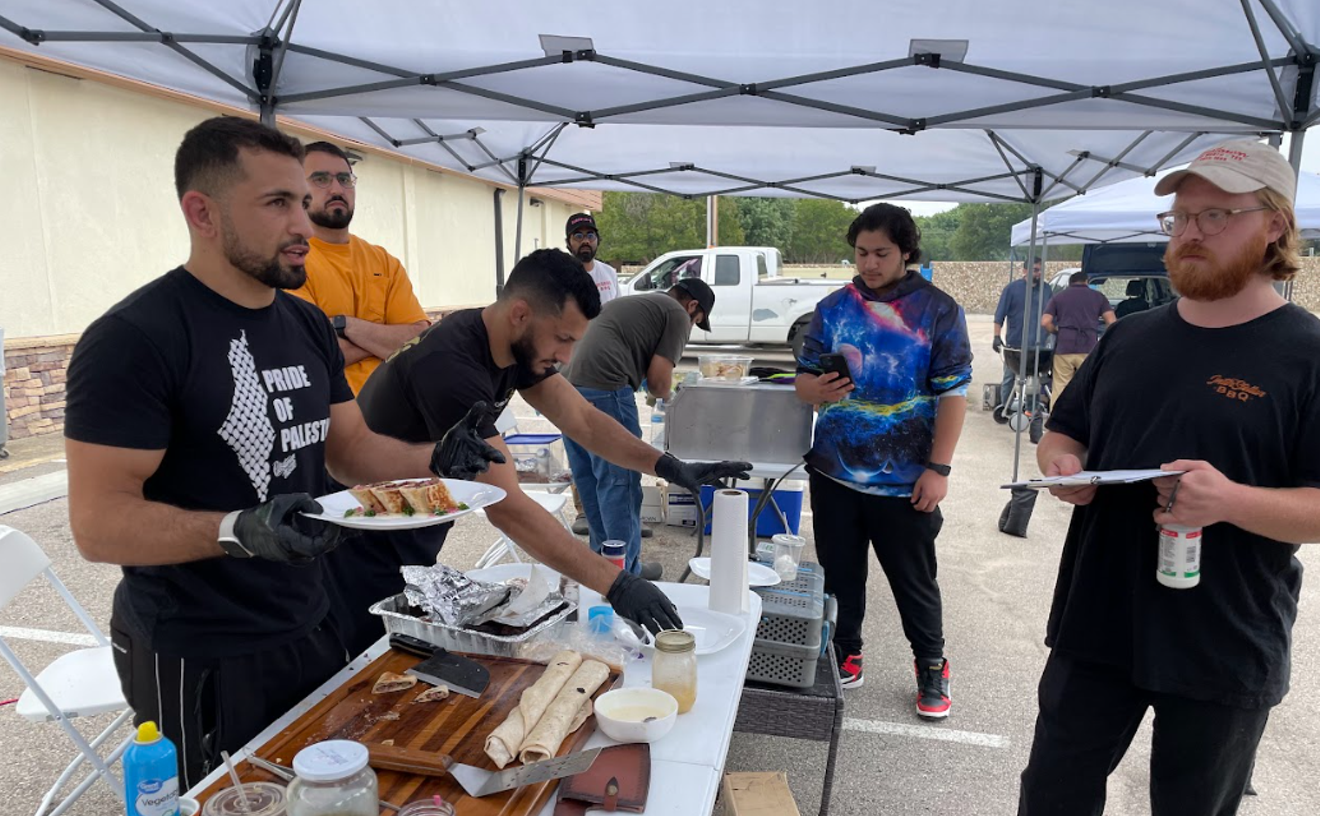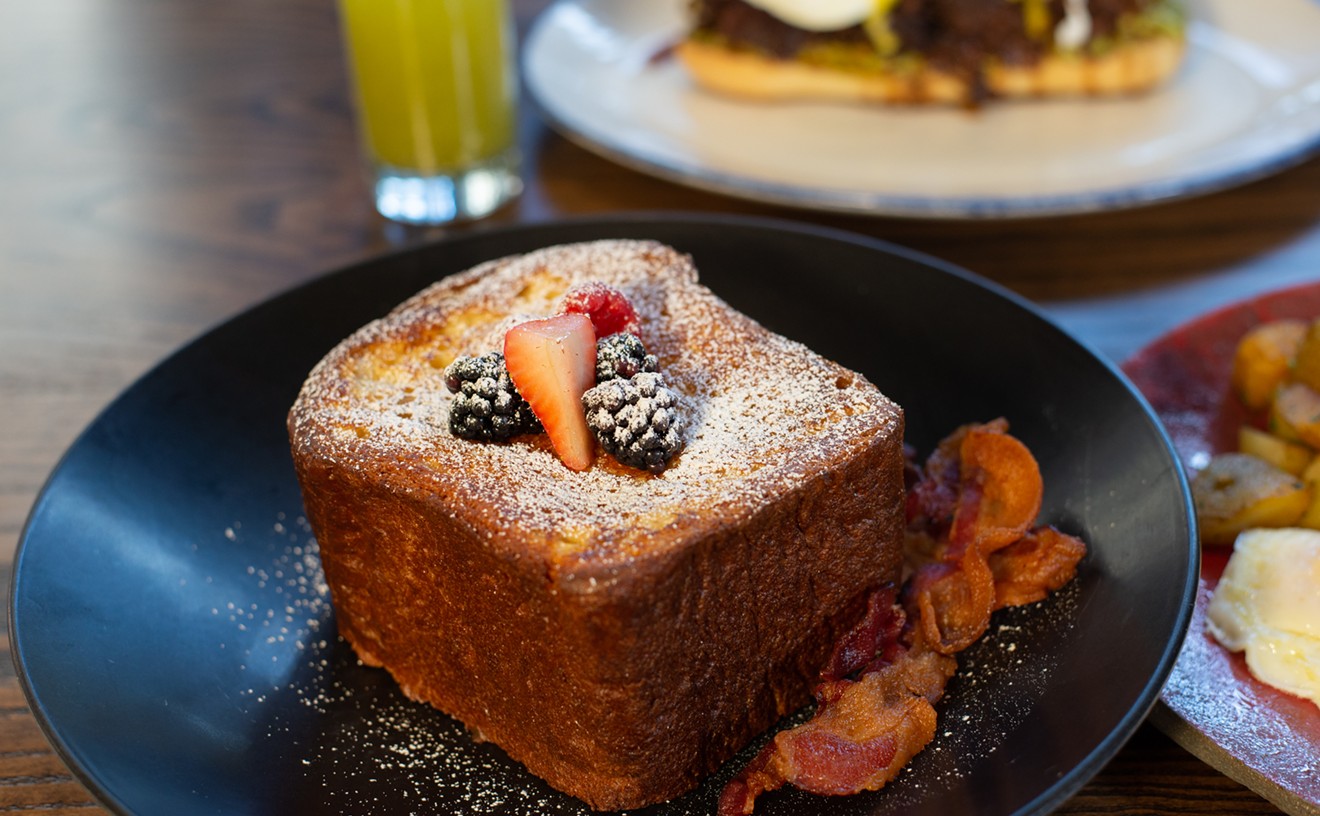Why not indeed? When you think about it, this response makes a lot of sense.
But a lot of us still want to know why Avner Samuel moves around so doggone much. I mean, is he an insufferable prima donna who packs his sauce pans and whisks as soon as he doesn't get his way? Or is he just trying to bring free agency to the restaurant business?
Maybe it's a little of both. Or maybe Samuel is simply the culinary version of the 21st-century worker: the buffed surfer on Alvin Toffler's Third Wave; the quintessential poster boy for Tom Peters' Thriving on Chaos management goulash; the ultimate hired gun with a bullet belt stuffed with coriander and peppercorns. At 41, Samuel exhibits the fluidity and fearless lust for change normally associated with twentysomething high-tech jocks who make money faster than the rest of us exceed our credit limits. If Samuel were a cyberspace exec instead of an executive chef, we wouldn't be asking why he job-hops so much--we'd be asking who gave him the fattest signing bonus this month.
Born in Israel and trained in Paris, Samuel came to Dallas some 16 years ago via Florida, where he worked as a chef at the Boca Raton Hotel and Club. In the years since, he's developed a distinctive style and a healthy ego that makes him doubly fun to watch.
"I do exciting things...as long as I do always better things than before, I don't see why not to move," he says. "[My food is] cutting-edge, creative, well-presented, and super-fresh. Whatever I produce has always been of the highest quality and is the most innovative."
And, as he likes to point out, he's had stints at some of Dallas' most revered eateries, including the Mansion on Turtle Creek, The Pyramid Room, Avner's on McKinney (which he owned), Yellow, the Landmark, and the Joint. His last stint was a return to Yellow, which closed just a few weeks after he revamped the menu. Samuel claims the white-tablecloth space failed to draw diners because it priced itself out of the McKinney market, where a casual mood now predominates. Who was in charge of that menu again?
Now Samuel has a new line item for his resume: Okeanos by Avner. For this latest stint, Samuel hooked up with Bahman Ayrom of Boerckel, Inc., a firm that owns Addison Cafe, Cafe Highland Park, and Farfallo. Samuel says Ayrom called him while he was shutting down Yellow to ask if he'd be willing to come on board as executive chef and rework the firm's aging restaurant menus. "He figured that with a person of my caliber and with the quality of the food, that I could take him to the next level," Samuel says. "It was very important for me not to compromise on the quality of the product, because obviously I've got a huge following in this city..."
But the poor gourmands keep slicing their fingers on Mapsco pages trying to figure out where the heck to find him. Now it's up north on restaurant row. Okeanos, which means ocean in Latin, Greek, and Hebrew, is Samuel's own creation under the Boerckel umbrella. He drenched the interior in baby blue with deviled-egg yellow trim because he said the ex-Bolero Mediterranean Grill space reminded him of the deck of a ship, which I guess fits in well with the name and "global seafood" menu. To me, though, the whole assembly, with its institutional-looking terra cotta tiles and unromantic fluorescent lighting, looks rather like a public restroom. A row of sinks would easily fit in under the mirrors on the west wall, and a collection of stalls seems a natural near the bar, which bears a striking resemblance to the elaborate beverage service carts you find in hotel hospitality suites.
Samuel dubs his menu "global cuisine" because he selects whatever international ingredients and techniques work well with his food. But by this definition, aren't Stouffer's frozen entrees "global cuisine?"
Despite the ambiguous culinary designation, Samuel turns out some highly imaginative creations--many similar to, or exact duplicates of, dishes from Yellow--and he takes daring risks, a few of which don't come off.
The ones that do work, however, hit you upside the head with their brilliance. One such example is the lobster bisque, which, not drubbed with too much butter and cream, is lighter and slightly redder in color than a traditional bisque. It has a rich seafood flavor that floods your palate with a savoriness that dissipates cleanly, leaving a fresh aftertaste rather than a heavy, viscous film.
And this is pretty much what you'll find across the menu: immaculate, well-articulated flavors. One appetizer, stir-fried crab fingers in garlic butter, is topped with pieces of cafir lime leaves (with a flavor profile that mimics lemon grass). It's amazing how simple stuff that most of us would consider Thai lawn mulch can transform the limbs of dismembered crustaceans into a whole new seafood creation. He quickly sautes these tiny crab claws in butter and chicken stock to ensure that the flesh is tender and sweet while he pulls way back on the garlic, creating tight, well-meshed layers of flavor.
And orchestrated interdependent layers are exactly what makes up the seared ahi tuna foie gras with leek compote. Maybe it was because I had too much white wine by the glass while I scoured the parchment menu, but I disassembled this appetizer as soon as it arrived and tasted the components separately to see if I could get some insight into Avner's inflated, roving mind. The tuna seemed mushy, the foie gras was oily and unappealing, and the compote was too salty. Yet when I put it back together and tasted it like a layered wedding cake, these flaws disappeared, and it danced in a rich, sophisticated surf-and-turf kind of way.
Another appetizer that inspired really deep culinary thoughts was the potato-crusted squid with Vietnamese vegetable salad and chilled carrot vinaigrette. Geez, what is it with ego-soaked chefs and endlessly long dish names? They constantly blather about ingredient simplicity, yet they construct menus that require Strunk and White decoder rings to read. Why couldn't this item be called spudded ink shooters in Charlie greens or Ho Chi Minh Hash to spare us the stress on our MTV-honed attention spans? Anyway, this bit of exotica swayed with the spicy, earthy flavor of daikon (an Asian radish) sprouts coupled with tender sweet squid strips and the aggressive crunch of a war-torn, barbed-wire mass of shredded iceberg lettuce, red and Napa cabbage, zucchini, and yellow squash accented with a bit of Japanese pickled ginger. The edges of the plate were drizzled with coriander oil and a pink curry-mayonnaise-lemon juice cocktail applied with a squeeze bottle. Lest you think this all sounds like an artsy fart on the palate of the common Dallas power diner, let me assure you that each flavor functioned expertly as part of this well-executed whole.
The entrees, for the most part, picked up on this appetizer excellence with, for example, the pan-seared California halibut on leek compote and sweet herb sauce; a dish that in our decoder ring shorthand could easily be dubbed "dude fish surfing in milk." This moist, flaky sea flesh swims in a reduction of white wine and cream spiked with basil, tarragon, coriander, oregano, and parsley topped with leeks poached in chicken stock. The whole thing proved light, provocative, and dashed with a bit of herbal sweetness.
Almost as good was the Maine lobster with lemon risotto, plum tomatoes, and green herbs. The lemon tang--not encumbered with butter--worked well with the tomato to cut into the lobster richness and open its flavors, while the risotto provided texture. But as I dug toward the bottom of the bowl, I found the risotto had coagulated into a thick paste.
Entrees that didn't work so well sprung mostly from the lunch menu. The cold (penne) pasta salad with vegetable spaghetti and grilled Pacific salmon medallions (whew) had some of the best bits of grilled salmon meat ever tasted. But the whole conglomeration was over-dressed, leaving it oily with an annoying sweetness. The fried catfish (coated with a Japanese bread crumb-cornmeal mixture) with shoestring potatoes and Okeanos tartar sauce was unbelievably void of flavor. And the grilled filet of beef tenderloin with crispy blue cheese wonton and mixed green salad (a dinner entree) showcased a fight in its midst: The strong tang of the demi-glace, flavored with tomato paste and red wine, sparred with the sharp bite of the blue cheese--both of which combined to wipe out the delicate flavors of the perfectly grilled cattle flesh. The clash was so belligerent, it was hard to enjoy a glass of the Ruffino Chianti Classico we ordered, as the wine was immediately crushed on the palate.
Which brings me to the wine list. Why, with a menu so innovative and global, is the wine selection so provincial and boring? Out of 22 wines, almost half are California Chardonnays, and only four wines are from outside the Golden State. This Chardonnay blubber could easily make room for an Italian Pinot Grigio, a Sancerre, a New Zealand Sauvignon Blanc, and an Australian Se'millon, while a Spanish Rioja and a lighter Ctes du Rhone would slip in nicely among the reds. This menu would be a blast with a tight, diverse selection of wines from all over. Why sell it short with vinified monotony?
Desserts were another disappointment. The Frangelica creme brulee, with a nice burnt sugar crust, didn't have discernible Frangelica flavor, and the inside was runny--more like a pudding than a custard. The cheesecake with raspberry sauce had a thick crust, something you don't see much these days. But there wasn't a whole lot of flavor--more bulk than pizzazz. One exciting offering, though, was the Far Niente Dolce, a Sauternes-style dessert wine rich in rhubarb and tropical fruit flavors. This wine may actually have been a better match for Samuel's blue cheese wonton-topped filet than a full-bodied red wine.
Samuel seems genuinely excited about his new venue. He says the Dallas restaurant scene is poised to enter a level of culinary excellence on a par with Chicago, San Francisco, and New York. "The customers are dying for that," he insists. Guess who Avner Samuel expects to lead this charge.
Okeanos. 5290 Belt Line Road at Montfort. (972) 490-8686. Lunch Monday-Friday 11 a.m.-2 p.m. Dinner Monday-Saturday 6 p.m.-10 p.m. Closed Sunday.
Stir-fried crab fingers $6.25
Potato-crusted squid $4.75
Pan-seared California halibut on leek compote $16.75
Grilled filet of beef tenderloin $18.75
Maine lobster with lemon risotto $19.75
Frangelica creme brulee $4.50
Far Niente Dolce $10










